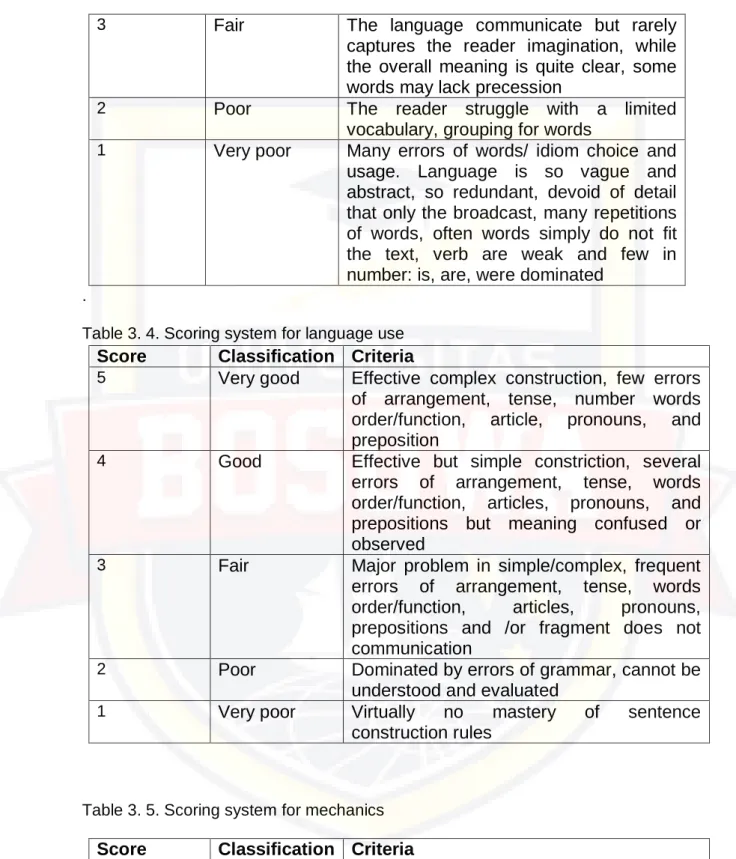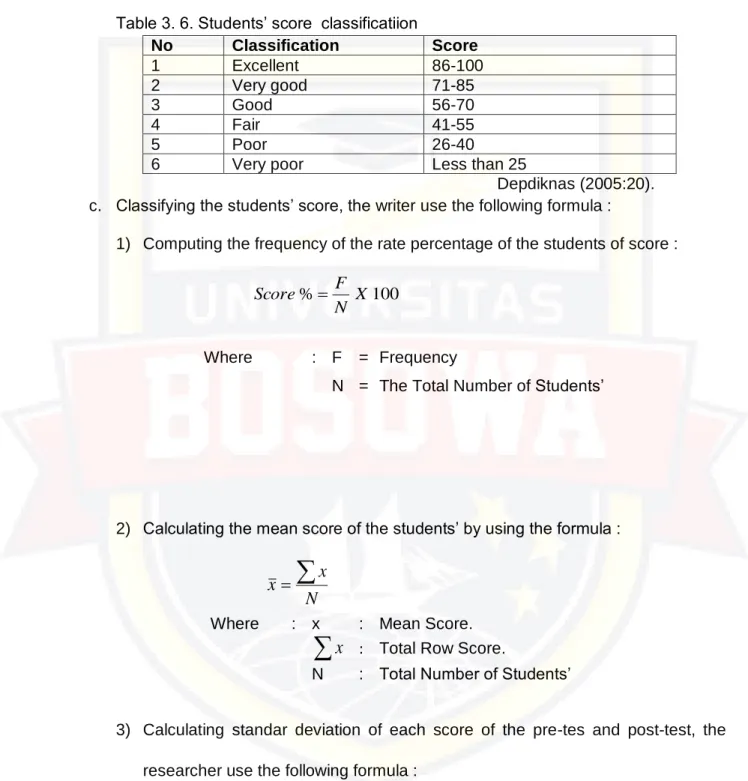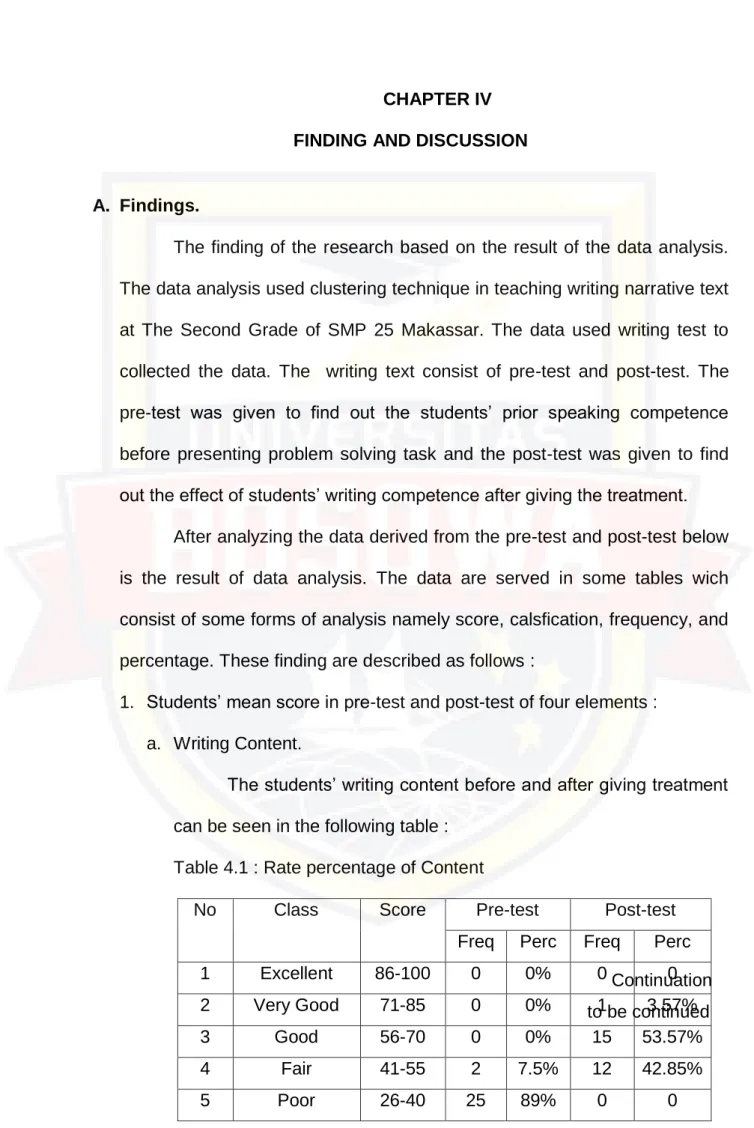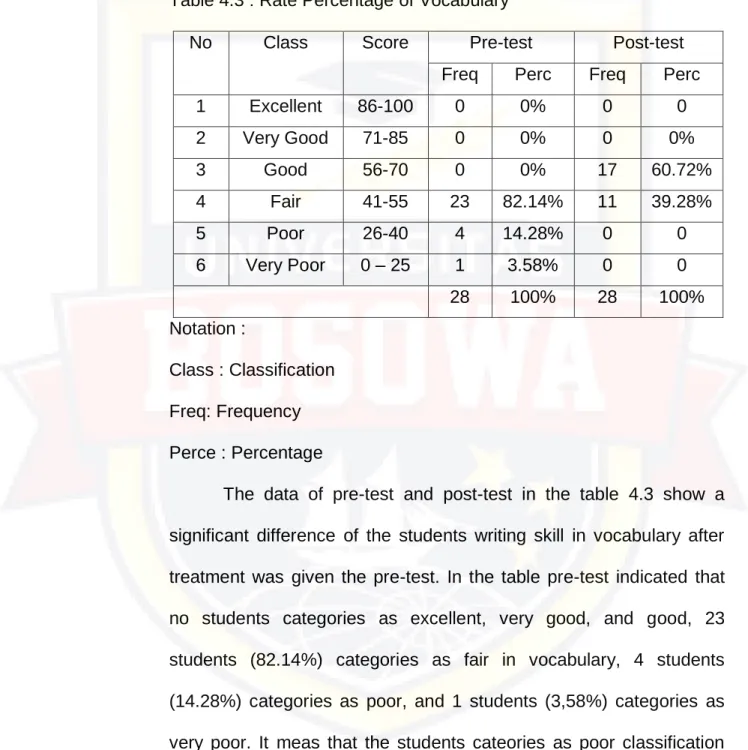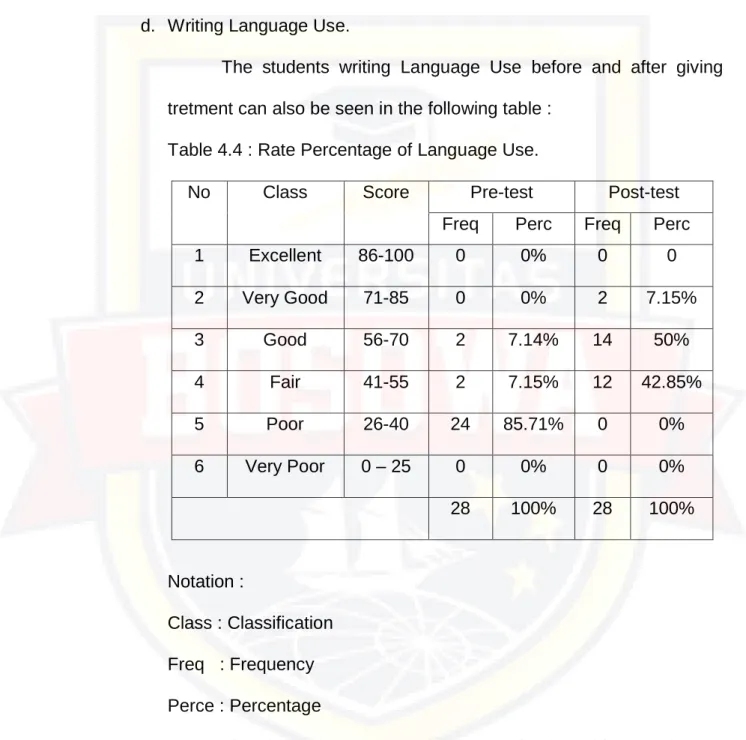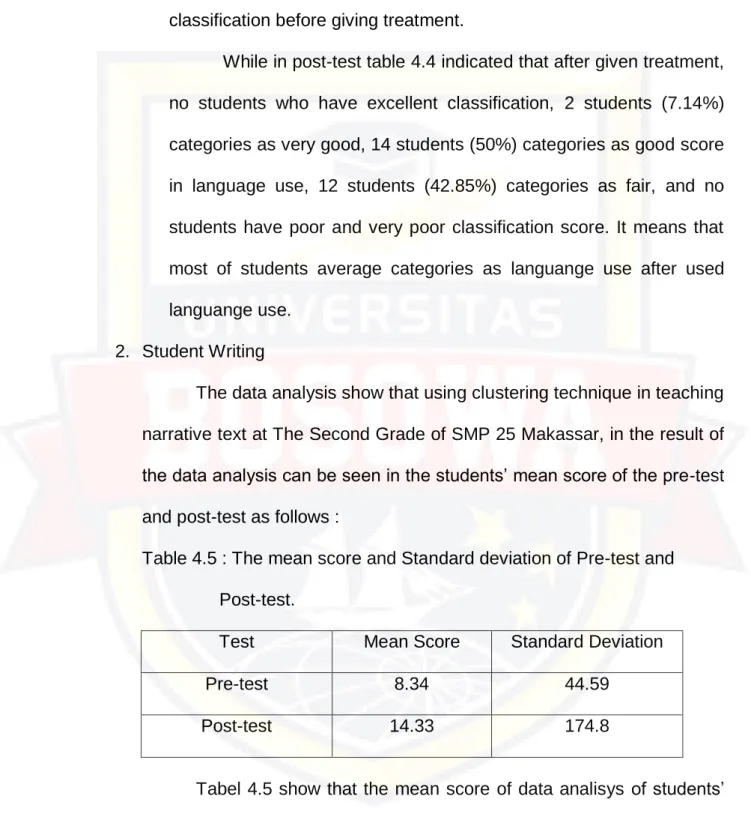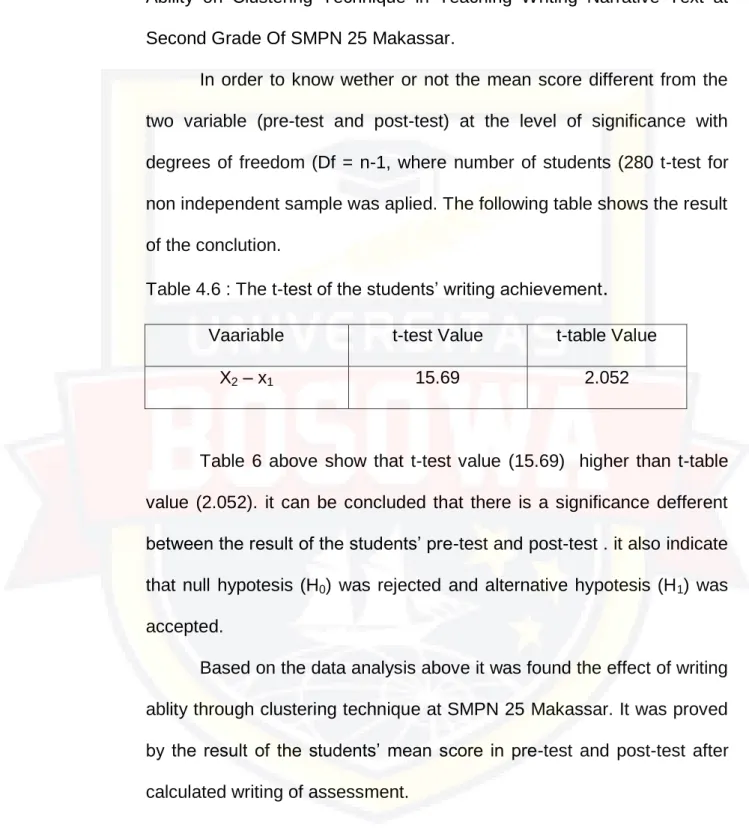Skripsi ini saya nyatakan berjudul "Penggunaan Teknik Pengelompokan dalam Pembelajaran Menulis Teks Narasi di Kelas Dua SMPN 25 Makassar" dan segala isinya adalah benar hasil karya saya didukung oleh beberapa pendapat ahli tentang teknik pengelompokan dan tidak ada plagiarisme. Tak lupa ayah saya I Wayan Suardana dan ibu saya Ni Kadek Lusiani yang selalu berdoa kepada Tuhan untuk kesuksesan saya juga diungkapkan oleh Penulis. Suryanti Ni Putu, 2017, Menggunakan teknik clustering dalam pembelajaran menulis teks naratif di kelas dua SMPN 25 Makassar (Dibimbing oleh St.
Suryanti Ni Putu, 2017, Menggunakan Teknik Pengelompokan dalam Pembelajaran Menulis Teks Narasi di Kelas Dua SMPN 25 Makassar Kelas VIII-B (Dibimbing oleh St. Haliah Batau dan Restu Januarty).
LIST OF APPENDICES
INTRODUCTION
- Background
- Research Question
- Objective of the Research
- Significance of the Research
- Scope of the Research
Today, some English teachers in SMP Negeri 25 Makassar still teach students writing by lecturing method without combining it with the other methods. The teacher often simply asks the students to write without giving a clear explanation and instruction about the writing, or does the writing tasks in the textbook or the students' worksheets. Based on the author's experience when they taught in SMP Negeri 25 Makassar, the teacher rarely used the variation in teaching writing.
For example, the teacher only used a textbook as a source of material and asked the students to do the writing tasks in the textbook. This makes the students passive during the writing class and unenthusiastic to do the writing tasks of the teacher. The teacher as manager, who has the power to manage the class, was able to create good, fun and interesting teaching and learning that enables the students to write narrative text in the class.
As a background, the researcher has conducted a preliminary research in which he gave students a pre-test to know the students' areas of difficulty in composition writing. Based on the above background, the writer formulates the research question as “How is the effect of grouping technique in teaching narrative text writing in the second grade of SMPN 25 Makassar. Based on the above problem statement, the objective of this research is to find out the effect of clustering technique in teaching narrative text writing in the second grade of SMPN 25 Makassar.
LITERATURE REVIEW
Previous Related Research Findings
Some Partinent Ideas
- The Concept of Writing a. Definition of Writing
Bram (1995:11) describes that writing is a kind of activity where the writer expresses all the ideas in his mind in the paper from words to sentence, sentence to paragraph and paragraph to essay. Ghaith (2002:4) also describes that writing is a complete process that allows the writer to explore thoughts and ideas, and make them visible and concrete. Therefore, the researcher concludes that writing is an activity to put our ideas in written form that all the elements of the language play an important role in this activity such as punctuation, spelling, grammar and vocabulary.
This aspect is very important because it allows the readers to immediately understand or recognize what the writer wanted to express in a final way. The use of favorable mechanics in written form will make it easier for the reader to understand the transfer of ideas, other messages given in written form. a) Capital letter. In addition, proper capitalization in a sentence also helps the reader distinguish one sentence from the others.
It can be used as a unit of meaning and suggest how its units relate to each other. In this research, the writer focused and analyzed five aspects based on content, organization, mechanics, language use and vocabulary in paragraph writing.
- Narrative Text
- Clustering Techniques
- The Characteristic of Good Paragraph
- Conceptual Framework
- Hypothesis
A narrative text is one that amuses and engages with problematic events leading to some kind of crisis tipping point which in turn finds resolution. The narrative text short story is telling a story or because of a sequence of events. In clustering, students write a topic in the center of the piece of paper and then write the ideas suggested by the topic around it.
Connect these with lines to the topic and follow the same procedures with their subtopics so this technique can help students stimulate and organize their ideas before they degenerate into paragraphs. The sequence of information is one paragraph, depending on the topic, the purpose of writing and the presence of the researcher. In this study, the researcher uses the quantum learning method as a treatment to see the possible effects on the writing skills of the students, and focuses on narrative text.
In this case, the researcher wonders if the students in the research location are able to improve their writing ability by grouping technique learning as a teaching method that they need to achieve. This research will use narrative text and in which narrative text focuses on telling a fictional story. To improve students' ability, the researcher identifies the analysis of the result of the research through a grouping technique.
RESEARCH METHOD
- Research Design
- Variables of the Research
- Population and Sample 1. Population
- Instrument of the Research
- Procedure of Collecting Data 1. Pre-Test
- Techniques of Data Analysis
The pre-test was carried out in both experimental and control each student as the first meeting. This test aimed to collect data on students' initial writing skills and to ensure that each student has similar abilities in writing skills before receiving the treatment. In this test, the author gave a paper to each student and instructed the students to write a narrative text for free.
In the writing process, the students wrote a topic in the middle of a piece of paper, and then wrote ideas suggested by the topic around it. Connect them with the topic with lines, follow the same procedures with their subtopics, so this technique can help the students to stimulate their ideas and to organize them before they develop into paragraph. After that, the researcher gave the students a paper to each student and gave a dictionary to guide the students in the writing process.
The subject of the post-test is the same as that of the pre-test. The result of the post-test is used to find out the students'. The post-test runs for 90 minutes. However, to make the students' scores more objective, the writer invited two supervisors to check the students' writing both in the pre-test and in the post-test.
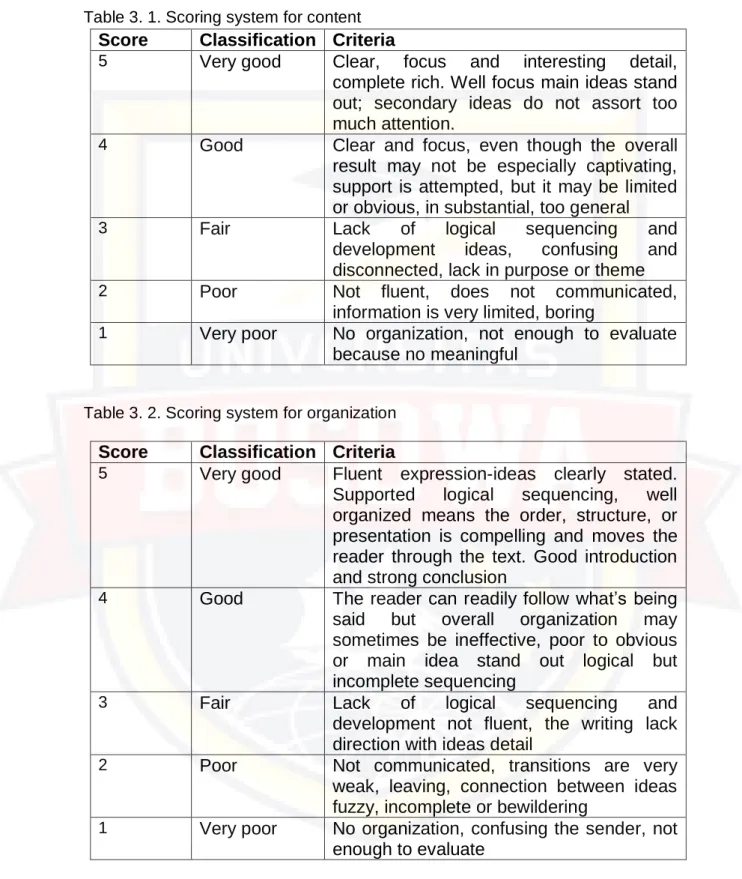
FINDING AND DISCUSSION
Findings
- Student Writing
The pre-test and post-test data in Table 4.1 show a significant difference in the writing skills of the students. categories fair, 25 students (89%) categorized as poor, and 1 student (3.5%) categorized as very poor. The pre-test and post-test data in Table 4.2 show a significant difference in students' writing skills in organization. In the table, the pe test indicated that no student categorized as excellent, very good, and good, 4 students (14.28%) categorized as fair in organization, 23 students (82.14%) categorized as poor, and 1 student (3.58%) ) categories as very poor.
The pre-test and post-test data in Table 4.3 show a significant difference in the students' vocabulary writing skills after the pre-test was given to the treatment. In the table, the pre-test indicated that no student rated the categories excellent, very good, and good, 23 students (82.14%) rated categories as fair in vocabulary, 4 students (14.28%) rated categories as poor, and 1 student (3.58%) categories as very poor. While in post-test Table 4.3 indicated that after the given treatment no students with excellent very and good classification, 17 students (60.72%) categorized as good, 11 students (39.28%) categorized as fair in content, and no student categories like poor and.
The pre-test and post-test data in Table 4.4 show a significant difference in students' written language skills. While Table 4.4 post-testing shows that after the treatment, there is no student who has an excellent score, 2 students (7.14%) categories as very good, 14 students (50%) categories as a good score in language use , 12 students (42.85% ) category as fair and no student has poor and very poor grade in classification. This means that most learners average the categories as language use for the language used.

Discussion
This was proven by the result of the students' average score in pre-test and post-test after calculated writing assessment. After that In pre-test the act before doing the treatment and determining the sample, the writer gives pre-test to know the areas of difficulty in writing. In this test, the researcher will give a paper to each student and instruct the students to write a narrative text for free.
During the teaching and learning process, English teachers often find that their students are unable to express their ideas in their writing. It is the experience of the English teacher of SMP Negeri 25 Makassar who states that there are three main problems in the writing of the students; lack of ideas, poor grammar and interference in the mother tongue. In the clustering step, the researcher will provide material and provide a written explanation of the clustering technique. Connect these with lines to the topic and follow the same procedures with their subtopics so that this technique can help the students stimulate their ideas and organize them before they degenerate into paragraphs, then the researcher will give the students a paper to each student and a dictionary to guide the students through the writing process.
The post-test score will be used to reveal students' achievement in writing skills. Using the grouping technique method could give an effect on the students' writing ability because there were many positive things that the students received during the treatment. It proved with their mean score in pre-test and post-test that showed a significant effect on writing content, organization, vocabulary and language use.
CONCLUSION AND SUGGESTION
Conclusion
- Clustering Technique is very helpful and effective way in improving students skill especially in writing ability
- There is significant effect of students writing ability in using clustering technique for writing narrative text
- The use of Clustering Technique in Teaching Writing Narrative Text at Second Grade of SMPN 25 Makassar was very poor before the writer
- Most of students are interested in learning skill used clustering technique method because clustering technique gave the students improvement in
- The Clustering Technique could give the writer can used the method for teaching English especially in writing narrative text
Suggestion
- The used of clustering technique in teaching with applied the correct media. It should be focuses on improvement of students‟ skill in writing
- Clustering Technique in proccess learning of the teacher should be involve the act of students in the active menner in proccess of learning
- The teacher suggest to be applied clustering technique to improve students writing ability besed on aspect of writing assesment
BIBLIOGRAPHY
